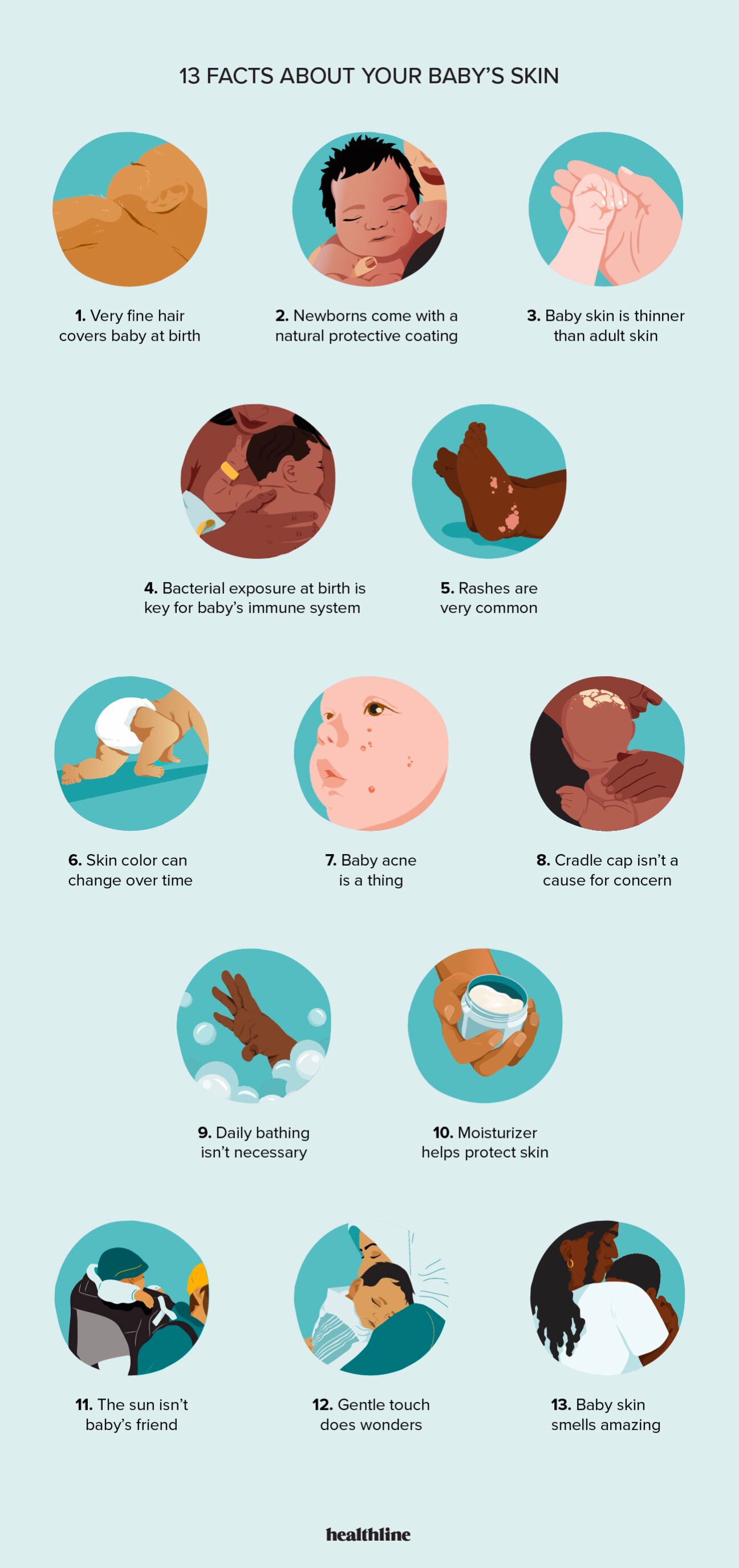A baby’s skin is achingly adorable, sensitive, delicious-smelling, and oh-so-soft. But there’s much more to it than that.
The structure of baby skin is
Let’s explore a few fascinating facts about baby skin.

Lanugo is super fine, soft, nonpigmented hair that fetuses grow early in development.
It’s the first type of hair a person has, and about
Lanugo plays an important role, holding vernix against the newborn’s skin.
Babies are born wearing 100% natural baby moisturizer — a creamy white substance called vernix caseosa, or just vernix.
Vernix
After birth, vernix helps prevent the skin from drying out, helps baby maintain a steady body temperature, and promotes immunity.
In the hours and days after birth, vernix slowly wears off with bathing and touch.
Skin thickness quickly increases in the first few months of life.
In the uterus, babies have nearly zero exposure to bacteria. But as soon as a baby is born, bacteria
These colonizer bacteria typically originate from the mother’s body — especially from the skin and vagina.
If your baby has a rash, it’s not necessarily cause for alarm.
Drool and spit-up rashes are also common. And don’t get us started on diaper rashes.
The American Academy of Pediatrics (AAP) recommends a few steps to prevent diaper rashes, including keeping the skin clean and dry, changing diapers frequently, and cleaning the area gently with each diaper change.
Nurturing Your Baby’s Unique Skin Needs
Skin conditions can look different on babies with black and brown skin, making it difficult to identify and treat issues early on. We’re here to empower you with the knowledge you need to confidently care for your baby’s skin.
Here’s how a few common skin conditions might show up on dark skin tones:
- Eczema: Instead of patchy redness, you might notice purple, dark brown, or ashen grey areas.
- Diaper rash: The rash may look dark brown or purplish instead of bright red, which is common with lighter skin tones.
- Dryness: Black and brown skin can be more prone to dryness and may need more frequent moisturizing.
Compared with adult skin, a baby’s skin is thinner, drier, and has
All these factors can make the color different from that of adult skin.
Newborn skin is also typically thinner than adult skin, so it appears to have more of a red or pink color thanks to the underlying blood vessels.
Baby acne happens in about 20% of babies at about 2 weeks of age, and it looks like small red dots on the skin.
It’s typically not a cause for concern and usually goes away within a few weeks or months, according to the American Academy of Dermatology.
Many babies get yellowish, greasy, scaly patches of scalp called cradle cap — a type of seborrheic dermatitis. It’s not itchy or contagious, and it’s not caused by allergies or hygiene issues.
It’s harmless and often goes away on its own by about 12 months of age. About 70% of 3-month-olds have cradle cap.
It may be caused by a strain of yeast on the scalp or related to overproduction of oil from a baby’s scalp glands.
You can try removing the scales on your own with gentle massage or combing, but never pick them because it might lead to an infection.
The AAP recommends bathing your baby about three times per week. Bathing too often can cause their skin to become too dry.
Additionally, it’s best to use liquid cleansers rather than bar soap or plain water because liquid cleansers often contain emollients — moisturizers that help protect and hydrate dry skin and prevent skin conditions such as eczema.
Using moisturizer on your baby’s skin
Consider asking your pediatrician to suggest a moisturizer — but they may not recommend using one if you have a preterm infant.
Baby skin is very sensitive to sunburn, and frequent sunburns and sun exposure in childhood are
Compared with adult skin, baby skin has less melanin, which usually helps protect the skin from UV damage.
The AAP recommends keeping babies under 6 months old out of the sun.
The simple act of touching your baby — caressing, hugging, nuzzling, having skin-to-skin time — is the most basic form of reassurance you can give them.
It’s an
In babies and caregivers, skin-to-skin contact is associated with higher levels of the bonding hormone oxytocin, reduced levels of the stress hormone cortisol, and increased feelings of safety.
Research suggests that parents with higher levels of oxytocin
Hugging your infant can give both of you a sense of safety and activate your parasympathetic nervous system, which
Infant massage is another great way to bond with your baby. Research suggests that it may even help relieve pain, improve jaundice, and help your baby gain weight.
Is there anything more delicious than baby smell? For some people, maybe not.
In one
Mothers can even distinguish the smell of their own babies from the scents of other babies, and
Baby skin is a wonderous thing. In the first months of your baby’s life, it’s important to keep their skin clean and dry, well moisturized, and shaded from the sun.
Many of the skin conditions that can happen in infancy are normal and will go away with time, but you should call your pediatrician if you’re concerned, if a skin issue is severe, or if it persists for longer than a few days.
Perhaps most importantly, know that taking time to be with your baby is essential.
Snuggling your baby, having skin-to-skin time, and giving them lots of loving, gentle touch are necessary to promote healthy development and help your baby feel safe and content.
